Drawing shadows along with objects gives an illustration some amount of reality. I was trying to illustrate shadows and felt like sharing some thoughts that I had. Probably a beginner may find it interesting. Anyways here it is...
To draw a shadow, one needs to be clear about properties of three things:
1) source of light (position, brightness, size)
2) the subject itself which casts the shadow (position, shape & size)
3) the surface on which shadow falls (position, shape & size)
Now how do these properties affect the shadow cast by the subject... ?
These two videos give you a basic idea of how shadow can be drawn and how the properties affect them. A must see... How to draw shadows and Drawing perspective shadows.
Some points to be noted are:
Size of shadow depends on distance between the source of light, object and surface of shadow. The size of the shadow increases as the distance between source of light and object decreases. The shadow appears blurred if either there are many sources of light or if it is far from the subject.
The shadow appears blurred if either there are many sources of light or if it is far from the subject.
The position(angle) of the source of light decides in which direction the shadow is cast.
The shape of shadow is also defined by the surface on which shadow is cast. shadow is irregular on irregular surfaces.
The 3 dimensional subject is cast as a two dimensional shadow whose shape is defined by the relative position of subject and source. For example see what objects can cast a square shadow and what shadows a cube can cast ... That would give you an idea.
After getting basic idea about shadow, the next point is how do we illustrate a shadow in Inkscape.
The basic method is duplicate the subject to create the shadow, give it a grey color and decrease its opacity. Then do the transforms like skew, stretch and move. What transforms and how much you need to perform depend on the properties of source of light,subject and surface that you saw earlier.
For 2D image editing softwares, the above idea can give good results for flat or simple sjubects. When the subject is a 2D illustration of a complex 3D object some amout of imagination and manual editing of the nodes of shadows is necessary.
Here is a small how to for illustrating shadow for a human figure. You can apply the technique for other objects also.
1) Draw ellipses using ellipses tool, rotate and arrange them as above to get a human form.
2) To draw the shadow, duplicate the subject (select subject and press ctrl+d)
select all the ellipses and do a path->union.
give it a grey (888888ff) color fill and 75% opacity.
3) Group the ellipses of subject (Ctrl+g)
For time being, place the shadow object above the subject.
Align(ctrl+shift+a, center along vertical, center along horizontal axes) them both so that they overlap each other completely.
4) Angle of source of light:
Click on the shadow layer twice, you will see the handle for skew operation.
Play with the skew operation holding shift key. This will give the angle at which the shadow is formed.
Depending on the position of source of light you can settle for a shadow.

5) Elevation of source of light
Now click on the shadow object once, you can see the squeeze or stretch handle.

play with this handle. this gives the elevation or the height of the source of light.
settle for required elevation.
So now we have a shadow of the object on a flat surface(floor).
What if there is a wall some distance behind the man, would the shadow be the same ?
lets see how to illustrate that.
A) Select the shadow and the wall surface and duplicate them.
Tthen do a path-->intersection. give this new shadow object the same fill and opacity as that of the shadow.
Send the old shadow to bottom (select shadow and press end key)
We need to do a skew to the new shadow as we did earlier for angle of shadow, this time the shadow must be vertical as below. B) The shadow that you got is not a perfect one, we need to do the stretch operation.
B) The shadow that you got is not a perfect one, we need to do the stretch operation.
Decrease the opacity of the wall so that you can see the old shadow.
Draw a reference line from the old shadow to the man's head.
Now stretch the new shadow as we had done earlier until it touches the reference line.
Now reset the opacity of wall and delete the reference line. The final result
The final result
Applying the same technique you can illustrate shadows on complex surfaces. Here is an example of shadow on steps.
Labels: basic, illustration, inkscape, shadow, tutorial
Brilliant cut is one of the most popular diamond cuts. It consists of 58 facets, 33 on the crown (topview) and 25 on the pavillion(bottomview). I was thinking of illustrating it and got a pretty decent Diamond. Have a look at it.
A diamond by ~rockraikar on deviantART
I just thought of sharing how to draw this. I have two png files at deviantart.com for top as well as bottom view.
Top view of diamond and Bottom view of diamond show how to draw them.
I haven't written more about filling with gradients there. Its pretty simple. Use a gradient with white & light greyish colors. It would be better if you have reduced the opacity of few colors because if we do an overlapping of these views , you will get a cool diamond as the one here.
I drew a cool Brilliant cut diamond Ring, looks pretty nice.
A diamond ring. by ~rockraikar on deviantART
If you have any doubts then please do mail or comment. You can also subscribe to my rss feed here.
Happy Inkscaping.
Labels: deviantart, diamond, inkscape
Painting is one of the oldest forms of art. One of my favorite painters happens to be Raja Ravi Varma. Romancing couple is one of my personal favorites. In fact in last century or so Hindus have seen Gods from his eyes ( I mean the way he has depicted). You can find a few of his paintings here.
Another painter that has fascinated the world happens to be Leonardo da Vinci. His paintings too have a great influence on how we see Jesus today. One of his greatest contributions to this world, 'The last supper' has gone online & I think everybody is really hooked onto it. The Nikon D2X camera took 1677 shots of the 460 x 880 cm painting powered by 2 Quad Core AMD Opteron processors to give a 16 billion pixels image of The Last Supper. It will be really advantageous to many art lovers as they can watch the minor details of the masterpiece live on their monitor screen and not have to travel to Milan. In fact they will get a better view of the painting sitting at their home. You can see the finest of the cracks in the painting. After Dan Brown's book 'The DaVinci code' , there will be many enthusiasts looking at this masterpiece eagerly.
If you still haven't seen the painting, here it is at the haltadefinizione's website.
At a resolution of 172181 x 93611, it really won't fit into any ordinary monitor so have to see it in pieces. At 100% zoom you can see 3.7 X 2 cm of the painting at a time. There is also the H9 watermark all over that may be disturbing to watch. It would have been better if there was some downloadable file that I could download to my machine and watch offline, but at that high resolution size downloading it is a big constraint too. May be they can provide some smaller resolution images for download.

If you are browsing with Internet explorer then press CTRL+A, else check this link.
Initially you saw Aishwarya , then when you selected the image you saw Abhishek. This is something called as CTRL+A images that I found through an email. So I thought of doing one. The one I got above is pretty decent one. You can google it up for CTRL+A images to find many more such images. There are also few pages explaining you how to do it, but all of them with Photoshop. I thought of posting a small How-To for all those who cannot buy Photoshop but can get a free copy of Gimp.
First of all, the funda behind the camouflaged image:
This image consists of two images embedded into each other. Alternate pixels from these two different images are selected into one image. Further the levels of the image to be hidden is varied to make it a bit invisible.
Why this image shows in MS applications only is that when image is selected in those applications it masks it with a grid showing only alternate pixels.
Requirements:
You need two images, Normal image and the Camouflaged image. The Normal image(one which you see normally) should be somewhat dense and varied so that it can cover the camouflaged image. Its better to stick to a simple single subject image for camouflaged image.
Steps: Fire up GIMP

1) Create a new image (appropriate size as that of your images). Drag and drop the two images into your new image. Let the layer containing image to be camouflaged be above the normal image layer.

2) Create a new layer above them (Layer-->New layer). We need to fill it with a grid pattern. You can create your own pattern of a grid with black & transparent blocks or else just download this pattern. Copy this into patterns folder of your Gimp installation.
3) Fill this new layer with this Grid pattern.(using bucket fill tool and selecting pattern fill from tool options tab)

4) Select this layer,zoom in about 800%, go to select-->select by color. Then select any black block from the grid.

5) Now select the image to be camouflaged in the layer dialog box and press CTRL+X to delete the selected pixels. Now zoom out to 100% and toggle the visibility of the Grid layer.

6) this will be a trial & error step. Once you get a hang of it you'll know what to do & how much to do. Now select the camouflaged image layer, go to Layers-->colors-->levels and adjust the output/input levels(move theoutput levels slider to the left) so that the camouflaged image's visibility decreases. Again toggle visibility of the grid layer to see the camouflaged image. By switching the visibility of the grid you can see how your final image will look. If you are not satisfied with the output, then undo(edit-->undo history, select levels & press undo) the levels adjustment and try once more.


7) When you are satisfied with step 7, you are ready to save. Tun off the visibilty of grid layer.Save the image as png or jpg format & view it.
Tips for good result:
The camouflaged image should blend into the normal image so choosing two images that blend in well is really important. Generally the normal image should be something that is filled with lots of objects & stuff and image to be camouflaged must be a simple object with plain background. To check if the images will blend in or not, after step 1, decrease the opacity (in layer dialog box) of camouflaged image to about 40% and using Move tool (press M or tools-->transform tools-->move) move the layer to see if this image hides in well. For the abhi aish image above there was some decent match between the two.
The step 7 is the most disturbing & annoying if you don't get it properly. Most of the times there will be a small shade of the hidden image. If you adjust the levels too much, you might not see the hidden image when selected. If you do the levels a bit less there will be a shade of hidden image.Its a compromise.
And one warning, don't try this with a large image. When you select the pixels, your system may get too slow. So try with smaller (about 600px width) images.
If you stumble upon some similar image what you can do is open it with gimp, create a new layer above it and fill it with grid pattern. Using move tool shift the grid layer, you can alternately see both the images.
I'm not pretty good at explaining, hope you find it useful. Happy camouflaging :)
I wanted to have a globe with those latitudes & longitudes on it.I was doing it manually earlier by duplicating and resizing, but there's the clone tool to do that easily. Here is a tutorial on how to do a simple globe with latitude/longitude. I have a very bad color sense so you can surely do a better job with colors. :)
Here is what we can have
1) draw a perfect circle (holding ctrl key) with no fill and black stroke. 2) Now we need to do some cloning.
2) Now we need to do some cloning.
Select the circle and go to edit-->clone-->create tiled clones.
Select 'simple translation' for symmetry and following settings for shift and scale.
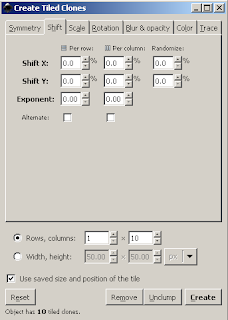
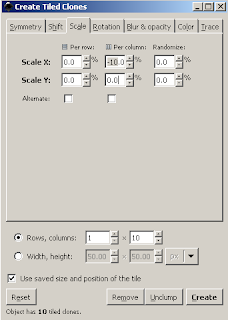 3) We will get something like this.
3) We will get something like this.Now select them all and go to edit-->clone-->unlink clone (or shift+alt+D)

4) Now draw a straight line from top center to bottom center to get the equator / meridian.
 5) Now duplicate this and do object-->rotate 90 degree.
5) Now duplicate this and do object-->rotate 90 degree.We have the latitude & longitudes. Now select these and go to path-->combine.
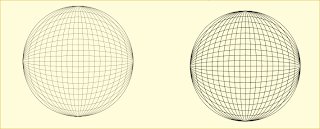 6) Now lets get back to the original circle give it a radial gradient.
6) Now lets get back to the original circle give it a radial gradient.And place the latitude/longitude globe over it. ( Use align and distribute tool to center the circles)
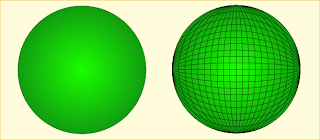 7) You can also give a radial gradient to the latitude/longitudes, to get something like this.
7) You can also give a radial gradient to the latitude/longitudes, to get something like this.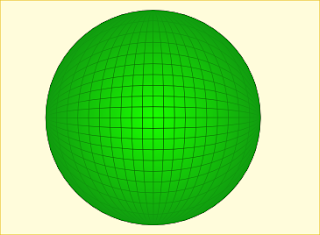 8) Now you can write something at the center of the globe with bezier tool using the latitude/longitude as a grid.
8) Now you can write something at the center of the globe with bezier tool using the latitude/longitude as a grid.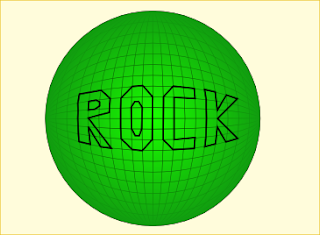 9) Now select these letters and move sideways for editing. Give them a color fill and remove the stroke.
9) Now select these letters and move sideways for editing. Give them a color fill and remove the stroke. 10) Do a path--> union of these letters and apply path-->simplify.
10) Do a path--> union of these letters and apply path-->simplify. 11) Give the text some suitable color, do some resizing(decrease height holding shift) and place it over the globe.
11) Give the text some suitable color, do some resizing(decrease height holding shift) and place it over the globe.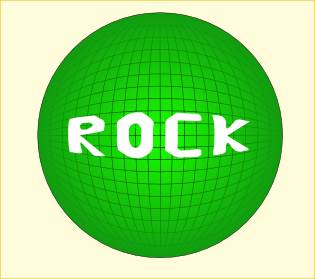
Further you can do things like giving the text or the globe a shadow effect etc like the one by heathenx here.
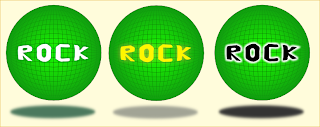
[ Edit: Stumbled upon this youtube video. Its really cool how you can build up on the globe layout... though its pretty tough to draw ]
The whole how-to in PNG format is available at deviantArt here. Happy Inkscaping.
I was just going through a few wallpapers and was impressed by Fractal's. A fractal is a geometric shape that in a part is made up of a smaller but similar shape. More about it here.
Wanting to try a few fractals I googled up and stumbled up on fractalview. Downloaded it from sourceforge and tried it. Its a java based so just had to set the classpath and ran it.
Fractalview is a java application for viewing a few common fractals ( Mandelbrot set, Julia set). It runs in a fullscreen mode showing up a fractal. By using different keys you can change the parameters like julia constant, colors or do a zoom and even save it as a PNG file.
Few fractals I captured are here.

The fractal view gallery has some good ones. Gimp has also got a very good plug-in for generating fractals called as fractal explorer It happens to be the easiest and best one I ever found.
Gimp has also got a very good plug-in for generating fractals called as fractal explorer It happens to be the easiest and best one I ever found.
Labels: fractal, sourceforge
I didn't really want to make "HOW TO WRITE YOUR NAME IN 3D" as the title of the post but yes, one curious artist landed on my blog from google search with the search string "HOW TO WRITE YOUR NAME IN 3D".
I'm also interested to write something in 3D but I dont have any 3D drawing softwares. Well I can use Inkscape for 3D looking text but its cumbersome & lot of work.
May be you need software like blender to do that or may be the google sketchup.
I tried with google sketchup.
here's the result
Then did a touch up with Gimp. Here's the result. All I did this in 4 minutes. So if you give it some time you can do wonders with it.
All I did this in 4 minutes. So if you give it some time you can do wonders with it.
Labels: gimp, googlesketchup
I am fascinated with Bézier curve and playing with it a lot these days. No graphic design software is complete without Bezier curves. The mathematical definitions here seem complicated, but the animations(Constructing Bézier curves in wikipedia) make for such easy understanding.
When working with Inkscape, this tutorial gives you the basic idea of editing bezier curves. Illustrating complex objects needs some mastery of bezier curves.
Here's an understanding my mind has about bezier curves.
Each bezier curve has two end points (p1 and p2) and two control points (c1 and c2).
Control line is line joining control point and corresponding end point(p1,c1 or p2,c2).
The shape of bezier curve depends on the position of control point, that is
a) distance between control point and the corresponding end point (control length).
b) angle made by control line with line joining end points (control angle).
The control line from an end point is tangent to the bezier curve starting from that end point.
A straight line is a bezier curve where control angles are zero.
A complex object can be drawn using multiple bezier curves.
Though control length may seem less important(in deciding the curvature) but when the end points are near, it makes a lot of difference.
Labels: bezier curve, inkscape
Got myself a deviantArt account. The designs there are superb.
By the way I tried to illustrate my Motorola C168 mobile handset using Inkscape. It has come up really cool though I could have given some time to bring in the details... Anyways I'm happy with what I got :)
My Moto C168 by ~rockraikar on deviantART
If you want to see what all objects makes this, the svg is here.
Labels: deviantart, illustration, mobile
1) A personal profile page using XHTML, CSS and bit of Javascript.
2) An Avatar image.
3) An email signature.
Proceedings...
Using Amaya and Nvu for designing the profile page. Nvu doesn't support XHTML and Amaya isn't user friendly for CSS editing (at least for me). I really like Nvu's CSS editing interface. To define structure and to abide by XHTML rules, will use Amaya and for CSS editing will use Nvu. Probably will be hosting it on googlepages . Wish Google did some work & improved the googlepages interface and gave its users some freedom. One important thing that I would like is labels for the uploaded files. It will really help me clean my messy uploaded stuff section.
An avatar, probably will use Inkscape and Gimp.
For email signature, i'll go with pure html and inline styles with minimal images. also have to make one for forums which will be pure image.
Labels: to_do
Illustrating objects to give it a 3D look requires a few transforms, unions, differences & most importantly the gradient. Here is a simple circle you can draw. The technique used here applies only for basic shapes and that too for particular orientations.
Only 3 objects is all you need to get this cool 3D looking ring.
here are the steps:
step1: Draw an ellipse (let the opacity be around 75% for our visualization)
Duplicate it and scale it to a smaller size holding shift & control.
step2: Duplicate these ellipses and move them out.
Duplicate them once more and shift them vertically up by few pixels(as in image)
step3: Select the two ellipses, duplicate them and move them out.
then do path-->difference
We have our object 1.
step4: Select the two smaller ellipses from the object in step 2, duplicate them and move them out.
Now do path-->difference. (check out which object should be above which one )
We have our object 2.
step5: Select the two larger ellipses from the object in step 2, duplicate them and move them out.
We need to draw a rectangle. Its width same as the width of the ellipse
and height equal to the vertical distance between the ellipses.
Select the lower ellipse and the rectangle and do path-->union. Move this object to bottom.
Select both these objects and apply path-->difference.
We have your object 3.
step6: Now what you need to do is assemble these objects.
Zoom in and arrange them.
step7: Next we need to color them.
for object 1, a plain fill is OK.
for object 2, we need a linear gradient with variation 'dark to light to dark'
for object 3, we need a linear gradient with variation 'light to dark to light'
make the opacity to 100%
PS: when aliging objects, there may be some gaps/white spaces between them.
to hide it, give the object a stroke with the same color/gradient of the fill.
You can do similarly for triangle and square shapes. A representation is here in the PNG & SVG files.
Grouping these objects, you can do cool 3D illustrations like this and many more.... the svg.
the svg.
For complex objects, and even for simple objects with different orientations, above technique is not suitable.Will try to cover that in next post.
Happy Inkscaping :)
